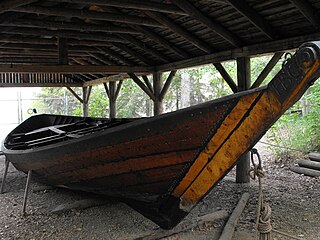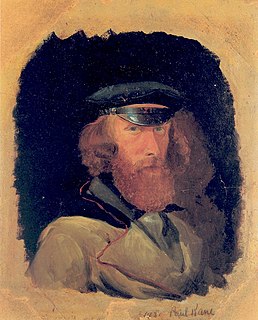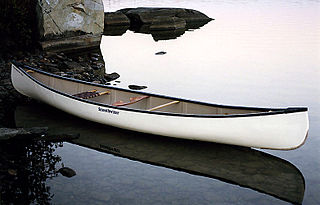
A canoe is a lightweight narrow water vessel, typically pointed at both ends and open on top, propelled by one or more seated or kneeling paddlers facing the direction of travel and using a single-bladed paddle.
A folding kayak is a direct descendant of the original Inuit kayak made of animal skins stretched over frames made from wood and bones. A modern folder has a collapsible frame made of some combination of wood, aluminium and plastic, and a skin made of a tough fabric with a waterproof coating. Many have integral air chambers inside the hull, making them virtually unsinkable.

John MacGregor, nicknamed Rob Roy after a renowned relative, was an English explorer, travel writer and philanthropist. He is generally credited with the development of the first sailing canoes and with popularising canoeing as a sport in Europe and the United States. He founded the British Royal Canoe Club (RCC) in 1866 becoming its first Captain and also founded American Canoe Association in 1880.

The Canadian Canoe Museum is a museum dedicated to canoes located in Peterborough, Ontario, Canada. The museum's mission is to preserve and share the culture and history of the canoe.

The York boat was a type of inland boat used by the Hudson's Bay Company to carry furs and trade goods along inland waterways in Rupert's Land, the watershed stretching from Hudson Bay to the eastern slopes of the Rocky Mountains. It was named after York Factory, the headquarters of the HBC, and modeled after the Orkney yole. Two variations to the York Boat were scows and "Sturgeon Heads."

Paul Kane was an Irish-born Canadian painter, famous for his paintings of First Nations peoples in the Canadian West and other Native Americans in the Columbia District.

A sneakbox is a small boat that can be sailed, rowed, poled or sculled. It is predominantly associated with the Barnegat Bay in New Jersey, just as the canoe-like Delaware Ducker is associated with the New Jersey marshes along the Delaware River near Philadelphia.

The York Factory Express, usually called "the Express" and also the Columbia Express and the Communication, was a 19th-century fur brigade operated by the Hudson's Bay Company (HBC). Roughly 4,200 kilometres (2,600 mi) in length, it was the main overland connection between HBC headquarters at York Factory and the principal depot of the Columbia Department, Fort Vancouver.

A duck decoy is a man-made object resembling a real duck. Duck decoys are sometimes used in waterfowl hunting to attract real ducks.

Lang Pioneer Village Museum is a living history museum located in the hamlet of Lang in Peterborough County, Ontario. It was established in 1967 by the County of Peterborough. Lang Pioneer Village is situated on the shores of the historic Indian River. Lang Pioneer Village is an "outdoor museum" featuring more than 30 restored and furnished buildings, many of which were donated from the surrounding townships. The buildings, constructed between 1820 and 1910, are interpreted by costumed villagers portraying authentic 19th-century pioneer life. Since 2014 the Museum has been the site of the Aabnaabin Encampment, a pre-colonization representation of a Michi Saagiig camp where the story of the First Nations history and culture of the region is told by indigenous interpreters. Lang Pioneer Village Museum is owned and operated by the County of Peterborough.

The Thompson Brothers Boat Manufacturing Company of Peshtigo, Wisconsin was a manufacturer of pleasure boats and canoes. Founded by brothers Peter and Christ Thompson in 1904, the company became prominent in the field and built boats for nearly one hundred years. The Thompson Antique & Classic Boat Rally celebrates the company's history with a boat show every other year and in 2013 the Thompson Brothers canoe was celebrated at the Annual Assembly of the Wooden Canoe Heritage Association.

Elizabeth Adela Forbes was a Canadian painter who was primarily active in the UK. She often featured children in her paintings and School Is Out is one of her most popular works. She was friends with the artists James Abbott McNeill Whistler and Walter Sickert, both of whom influenced her work. Her etchings in particular are said to show the influence of Whistler.

Old Town Canoe Company is a historic maker of canoes in Old Town, Maine. The company had its beginnings in 1898, in buildings constructed in 1890 for a shoe business, and was incorporated in 1901. Old Town entered the canoe market as a builder of canvas-covered wooden canoes. In the latter half of the 20th century, the company adopted more modern materials to maintain competitiveness. The company's plant was located along the Penobscot River.

Chestnut Canoe Company was established in Fredericton in the Canadian province of New Brunswick at the end of the 19th century and became one of the pre-eminent producers of wood-and-canvas canoes. The company closed in 1979.
The E.M. White Canoe Company was founded by Edwin White, who produced wood and canvas canoes from 1889 into the 1940s. White is considered one of the pioneers of wood and canvas canoe building and one of several prominent canoe builders in Maine.
Boat building has been a part of the history of Ontario, Canada for thousands of years. From the hand-crafted birch bark canoes of the indigenous people to modern factory-built speedboats, the construction of small boats for fishing, transportation and later water sports has been a widespread commercial activity in the province.

The B.N. Morris Canoe Company of Veazie, Maine, produced wood and canvas canoes from 1891 until fire destroyed the factory late in 1919. The shapeliness, style, and workmanship of the Morris canoes and boats made some of the most picturesque craft that were ever built with this construction form.

Ted Moores is a Canadian boat builder, author, and educator. His book Canoecraft has sold over 300,000 copies worldwide.

Lashed-lug boats are ancient boat-building techniques of the Austronesian peoples. It is characterized by the use of sewn holes and later dowels ("treenails") to stitch planks edge-to-edge onto a dugout keel and solid carved wood pieces that form the caps for the prow and stern. The planks are further lashed together and to ribs with fiber ropes wrapped around protruding carved lugs on the inside surfaces. Unlike carvel construction, the shell of the boat is created first, prior to being fastened to the ribs. The seams between planks are also sealed with absorbent tapa bark and fiber that expands when wet or caulked with resin-based preparations.</ref>

Canadian is the byname used in some countries for the descendants of the birch bark canoe that was used by the indigenous peoples of Northern America as a convenient means of transportation in the densely forested and impassable areas of Northern America.





















